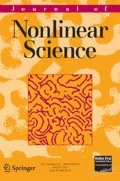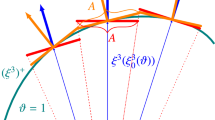Abstract
In this paper, we continue the development of mathematically rigorous theory of “near-flip” buckling of slender bodies of arbitrary geometry, based on hyperelasticity. In order to showcase the capabilities of this theory, we apply it to buckling of axially compressed circular cylindrical shells. The theory confirms the classical formula for the buckling load, whereby the perfect structure buckles at the stress that scales as the first power of shell’s thickness. However, in the case of imperfections of load, the theory predicts scaling instability of the buckling stress. Depending on the type of load imperfections, buckling may occur at stresses that scale as thickness to the power 1.5 or 1.25, corresponding to the lower and upper ends, respectively, of the historically accumulated experimental data.

Similar content being viewed by others
Notes
While hyperelasticity is hardly the “ultimate” theory of elasticity, it is sufficiently general to capture buckling of slender structures.
Alternatively, scaling of the forces and additional information on how the forces are applied, sufficient to determine the scaling of the energy, may be given.
The question of existence of the buckling mode \(\varvec{\phi }^{*}_{h}\) is irrelevant here, since the goal of this discussion is to motivate our somewhat unusual definition of a buckling mode below, which makes no existence assumptions.
This is a consequence of a classical result in matrix algebra, due to I. Schur, that even though the product of two positive definite matrices do not have to be positive definite, its trace is always positive.
Of course, it is the family of bodies \(\Omega _{h}\) that may or may not be “slender” according to our definition. We abuse the terminology for the sake of euphony.
The former happens when \(\sigma _{1}+\sigma _{2}<0\), where \(\sigma _{1}\le \sigma _{2}\le \sigma _{3}\) are the principal stresses, the latter when \(\sigma _{2}+\sigma _{3}<0\).
We note that \(s=\)constant is a consequence of \(u^{1}_{z}(\theta ,0)=0\), while \(t=\)constant is a consequence of \(u^{1}_{\theta }(\theta ,0)=0\).
We emphasize that we are studying stability of the nonlinearly elastic trivial branch in the context of fully nonlinear hyperelasticity. Linear elastic equations supply the leading-order asymptotics of the fully nonlinear critical load.
Recall that we are investigating imperfections of load where the boundary conditions at \(z=L\) are not fully specified. This gives us just enough freedom to choose \(\beta _{0}\) arbitrarily.
References
Almroth, B.O.: Postbuckling behaviour of axially compressed circular cylinders. AIAA J. 1, 627–633 (1963)
Brush, D.O., Almroth, B.O.: Buckling of Bars, Plates, and Shells. McGraw-Hill, New York (1975)
Budiansky, B., Hutchinson, J.: A Survey of Some Buckling Problems. Technical report CR-66071, NASA, February (1966)
Budiansky, B., Hutchinson, J.: Buckling: progress and challenge. In: Besseling, J.F., van der Heijden, (eds.) Trends in Solid Mechanics 1979. Proceedings of the Symposium Dedicated to the 65 th Birthday of W. T. Koiter, pp. 185–208. Delft University, Delft University Press Sijthoff & Noordhoff International Publishers (1979)
Calladine, C., Barber, J.: Simple experiments on self-weight buckling of open cylindrical shells. J. Appl. Mech. 37(4), 1150–1151 (1970)
Calladine, C.R.: A shell-buckling paradox resolved. In: Durban, D., Givoli, G., Simmonds, J.G. (eds.) Advances in the Mechanics of Plates and Shells, Volume 88 of Solid Mechanics and its Applications, pp. 119–134. Kluwer Academic Publishers, Dordrecht (2002)
Euler, L.: Methodus inveniendi lineas curvas maximi minimive proprietate gaudentes sive solutio problematis isoperimetrici latissimo sensu accepti, Additamentum I. De curvis elasticis. Bousquet, Lausannae et Genevae, 1744. Opera Omnia, Ser. I, Vol. 24. English translation by Oldfather, W. A. and Ellis, C. A. and Brown, D. M. in Isis 20(1), 72–160 (1933)
Fosdick, R., Foti, P., Fraddosio, A., Piccioni, M.D.: A lower bound estimate of the critical load for compressible elastic solids. Continuum Mech. Thermodyn. 22(2), 77–97 (2010)
Friedrichs, K.O.: On the boundary-value problems of the theory of elasticity and Korn’s inequality. Ann. Math. 48(2), 441–471 (1947)
Friesecke, G., James, R.D., Müller, S.: A theorem on geometric rigidity and the derivation of nonlinear plate theory from three-dimensional elasticity. Commun. Pure Appl. Math. 55(11), 1461–1506 (2002)
Friesecke, G., James, R.D., Müller, S.: A hierarchy of plate models derived from nonlinear elasticity by gamma-convergence. Arch. Ration. Mech. Anal. 180(2), 183–236 (2006)
Goldenveizer, A.L.: Mathematical rigidity of surfaces and physical rigidity of shells. Mech. Solids 14(6), 65–77 (1979)
Gorman, D.J., Evan-Iwanowski, R.M.: An analytical and experimental investigation of the effects of large prebuckling deformations on the buckling of clamped thin-walled circular cylindrical shells subjected to axial loading and internal pressure. Dev. Theor. Appl. Mech. 4, 415–426 (1970)
Grabovsky, Y., Harutyunyan, D.: Exact scaling exponents in Korn and Korn-type inequalities for cylindrical shells. SIAM J. Math Anal. 46(5), 3277–3295 (2014)
Grabovsky, Y., Harutyunyan, D.: Rigorous derivation of the buckling load in axially compressed circular cylindrical shells. J. Elast. 120(2), 249–276 (2015)
Grabovsky, Y., Truskinovsky, L.: The flip side of buckling. Contin. Mech. Thermodyn. 19(3–4), 211–243 (2007)
Griggs, J.: Experimental study of buckling of thin-walled cylindrical shells. Masters of arts thesis, Temple University, Philadelphia, PA (2010)
Hill, R.: On the elasticity and stability of perfect crystals at finite strain. Math. Proc. Camb. Philos. Soc. 77, 225–240 (1975)
Holden, J.T.: Estimation of critical loads in elastic stability theory. Arch. Ration. Mech. Anal. 17, 171–183 (1964)
Horák, J., Lord, G.J., Peletier, M.A.: Cylinder buckling: the mountain pass as an organizing center. SIAM J. Appl. Math. 66(5), 1793–1824 (2006). (electronic)
Hunt, G., Lord, G., Champneys, A.: Homoclinic and heteroclinic orbits underlying the post-buckling of axially-compressed cylindrical shells. Comput. Methods Appl. Mech. Eng. 170(3), 239–251 (1999)
Hunt, G., Lord, G., Peletier, M.: Cylindrical shell buckling: a characterization of localization and periodicity. Discrete Continuous Dyn. Syst. Ser. B 3(4), 505–518 (2003)
Hunt, G., Neto, E.L.: Localized buckling in long axially-loaded cylindrical shells. J. Mech. Phys. Solids 39(7), 881–894 (1991)
Hunt, G.W., Neto, E.L.: Maxwell critical loads for axially loaded cylindrical shells. Trans. ASME 60, 702–706 (1993)
Koiter, W.T.: On the Stability of Elastic Equilibrium. PhD thesis, Technische Hogeschool, Technological University of Delft, Delft, Holland (1945)
Lancaster, E., Calladine, C., Palmer, S.: Paradoxical buckling behaviour of a thin cylindrical shell under axial compression. Int. J. Mech. Sci. 42(5), 843–865 (2000)
Lewicka, M., Mahadevan, L., Pakzad, M.R.: The Föppl-von Kármán equations for plates with incompatible strains. Proc. R. Soc. Lond. Ser. A Math. Phys. Eng. Sci. 467(2126), 402–426 (2011). With supplementary data available online
Lewicka, M., Mora, M.G., Pakzad, M.R.: The matching property of infinitesimal isometries on elliptic surfaces and elasticity of thin shells. Arch. Ration. Mech. Anal. 200(3), 1023–1050 (2011)
Lord, G., Champneys, A., Hunt, G.: Computation of localized post buckling in long axially compressed cylindrical shells. Philos. Trans. R. Soc. Lond. Ser. A Math. Phys. Eng. Sci. 355(1732), 2137–2150 (1997)
Lorenz, R.: Die nicht achsensymmetrische Knickung dünnwandiger Hohlzylinder. Phys. Z. 12(7), 241–260 (1911)
Mandal, P., Calladine, C.: Buckling of thin cylindrical shells under axial compression. Int. J. Solids Struct. 37(33), 4509–4525 (2000)
Mora, M.G., Müller, S.: A nonlinear model for inextensible rods as a low energy \(\Gamma \)-limit of three-dimensional nonlinear elasticity. Ann. Inst. H. Poincaré Anal. Non Linéaire 21(3), 271–293 (2004)
Southwell, R.V.: LXX. On the collapse of tubes by external pressure. Philos. Mag. Ser. 6 25(149), 687–698 (1913a)
Southwell, R.V.: XXXVIII. On the collapse of tubes by external pressure—II. Lond. Edinb. Dublin Philos. Mag. J. Sci. 26(153), 502–511 (1913b)
Southwell, R.V.: LX. On the collapse of tubes by external pressure—III. Lond. Edinb. Dublin Philos. Mag. J. Sci. 29(169), 67–77 (1915)
Tennyson, R.C.: An Experimental Investigation of the Buckling of Circular Cylindrical Shells in Axial Compression Using the Photoelastic Technique. Technical report 102, University of Toronto, Toronto, ON, Canada (1964)
Timoshenko, S.: Towards the question of deformation and stability of cylindrical shell. Vesti Obshestva Tekhnologii 21, 785–792 (1914)
Timoshenko, S., Woinowsky-Krieger, S.: Theory of Plates and Shells, vol. 2, 2nd edn. McGraw-Hill, New York (1959)
von Kármán, T., Dunn, L.G., Tsien, H.-S.: The influence of curvature on the buckling characteristics of structures. J. Aeronaut. Sci. 7, 276–289 (1940)
Von Mises, R.: Der kritische aussendruck zylindrischer Rohre. VDI-Zeitschrift 58(19), 750–755 (1914)
Weingarten, V.I., Morgan, E.J., Seide, P.: Elastic stability of thin-walled cylindrical and conical shells under axial compression. AIAA J 3, 500–505 (1965)
Yamaki, N.: Elastic Stability of Circular Cylindrical Shells, vol. 27. Appl. Math. Mech. North Holland (1984)
Zhu, E., Mandal, P., Calladine, C.: Buckling of thin cylindrical shells: an attempt to resolve a paradox. Int. J. Mech. Sci. 44(8), 1583–1601 (2002)
Acknowledgments
We are grateful to Eric Clement, Robert V. Kohn, Stephan Luckhaus, Mark Peletier, and Lev Truskinovsky for insightful comments and questions. We also want to thank the anonymous referees whose suggestions helped improve the exposition. This material is based upon work supported by the National Science Foundation under Grants No. 1412058.
Author information
Authors and Affiliations
Corresponding author
Additional information
Communicated by Robert V. Kohn.
Appendix: Nonlinear Trivial Branch for a Neo-Hookean Material
Appendix: Nonlinear Trivial Branch for a Neo-Hookean Material
We note that in order to derive the asymptotics of the critical load in the presence of torsion, only the explicit linear trivial branch (4.14) is needed. However, for the result to be legitimate, we also need to know the existence of the regular trivial branch, and not its explicit representation. At the moment, we lack tools for establishing existence of regular trivial branches, nor can we exhibit one entirely explicitly for a material whose energy density satisfies our regularity assumptions. Here we derive an explicit form of the regular trivial branch for an incompressible neo-Hookean material in the way of providing “evidence” for our assumption of existence of the regular trivial branch for compressible materials.
The strain energy density function for a neo-Hookean solid has the form
We are looking for a trivial branch in a cylindrical shell, given in cylindrical coordinates by
where \(\psi (r)\) also depends on \(\alpha \), \(\lambda \), and h. When \(\alpha =0\), we expect that \(\psi (r)\) will reduce to \((a(\lambda )+1)r\), as in (3.4). We remark that the ansatz (6.2) should also work for isotropic compressible materials with strain energy density
except the resulting nonlinear second-order boundary value problem for \(\psi (r)\)
cannot be solved explicitly.
Returning to the neo-Hookean solid (6.1), we must have
and hence,
for some \(\beta >-1\).
The Piola–Kirchhoff stress function is
where the Lagrange multiplier \(\hat{p}\) plays the role of pressure. For \(\varvec{y}\), given by (6.2) and \(\varvec{F}=\nabla \varvec{y}\), we compute
The traction-free condition \(\varvec{P}\varvec{e}_{r}=\varvec{0}\) on \(r=1\pm h/2\) can be written as
The formula for \(\varvec{F}^{T}\varvec{F}\), together with \(\det \varvec{F}=1\), implies that
This suggests that it is reasonable to look for the trivial branch for which the function \(p(r,\theta ,z)\) depends only on r. Under this assumption, we compute
where
It follows that \(\nabla \cdot \varvec{P}=\varvec{0}\) results in a single ODE for p(r):
Substituting (6.4) for \(\psi (r)\) into (6.6) and solving for p(r), we obtain
for some constant of integration \(\gamma \). The traction-free boundary conditions (6.5) become
To simplify notation, we denote
Then (6.7) can be written as
Eliminating \(\gamma \) from (6.8), we obtain
when h is small
Thus, when \((h,\lambda )\rightarrow (0,0)\), \(\beta \approx -\alpha ^{2}/2\). We conclude that \(\alpha \), and, therefore, \(\beta \) must go to zero, as \(\lambda \rightarrow 0\), since otherwise the trivial branch \(\varvec{y}(\varvec{x};h,\lambda )\), given by (6.2), (6.4) will not emanate from the undeformed configuration. The regularity of the trivial branch in \(\lambda \) demands that \(\alpha (h,\lambda )\sim \alpha _{0}(h)\lambda \), as \(\lambda \rightarrow 0\). Thus, for an arbitrary fixed parameter \(\beta _{0}>0\), we setFootnote 11 \(\beta =-\beta _{0}^{2}\lambda ^{2}/2\), resulting in the explicit expression for the parameter \(\alpha \):
Hence, the nonlinear trivial branch has the form
where \(\beta _{0}>0\) is a constant and \(\alpha (\lambda ,h)\) is given by (6.9). We compute
Therefore, the linearized trivial branch displacement \(\varvec{u}^{h}\) is given by
The corresponding linear stress and its \(h\rightarrow 0\) limit are
Rights and permissions
About this article
Cite this article
Grabovsky, Y., Harutyunyan, D. Scaling Instability in Buckling of Axially Compressed Cylindrical Shells. J Nonlinear Sci 26, 83–119 (2016). https://doi.org/10.1007/s00332-015-9270-9
Received:
Accepted:
Published:
Issue Date:
DOI: https://doi.org/10.1007/s00332-015-9270-9
Keywords
- Buckling
- Cylindrical shell
- Instability
- Second variation
- Critical load imperfection sensitivity
- Scaling exponents




